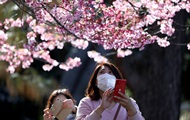An international team of scientists has found that in the spring, people may become more susceptible to coronavirus infection due to an increase in the concentration of pollen in the air.
The risk of contracting coronavirus infection increases in the spring, when plants begin to bloom, and not only in people allergic to pollen, scientists have found. Pollen exposure to the body reduces the antiviral interferon response. Correspondent.net tells the details.
Pollen weakens the immune response
An international team of scientists led by experts from the Technical University of Munich and the Helmholtz Center for Health and Environment Research conducted a study that showed that the risk of infection with coronavirus increases during the flowering season.
The researchers concluded that spring bloom was a factor in the rapid spread of coronavirus in the first half of 2020 in the countries of the Northern Hemisphere.
It is known that the effect of pollen on the body reduces the antiviral interferon response, making various infections more dangerous.
Since SARS-CoV-2 is sensitive to interferons, proteins secreted by cells in response to a virus invasion, the researchers decided to test whether pollen could affect people’s vulnerability to COVID-19.
According to their hypothesis, the more pollen from flowering plants is carried through the air in the spring, the more new cases of coronavirus infection.
From January to April 2020, researchers examined data from 130 aeropalinological monitoring stations from 31 countries and compared them with information on weather conditions and the number of COVID-19 infections in the spring months of last year, when European countries experienced the first wave of the pandemic.
Causes of thrombosis in coronavirus
Scientists also took into account quarantine restrictions and other infection control methods that were introduced in a particular country in March and April 2020.
“The more pollen, the more pronounced the effect”, – quotes DW member of the research group, medical specialist for environmental studies, professor at the Technical University of Munich Claudia Tridel-Hoffmann.
According to Professor Tridel-Hoffman, the body of allergy sufferers gives a weaker interferon response to the appearance of the virus. However, until now, the Robert Koch Institute has not included patients with allergies at risk.
During the flowering of plants, the number of infections increases by four percent if the country does not have strict quarantine, the researchers calculated.
It is noted that the increase in the incidence can be 44 percent at the appropriate temperature and humidity.
Very often, the incidence rate rose sharply after a very high concentration of pollen was noted in the air for four days.
For example, such a picture was observed from March 10 to March 14, 2020, when a wave of pollen from flowering trees covered Europe, along with warm weather. After that, the rate of spread of the infection began to grow exponentially.
The record was set in several cities in Germany, where in the spring of 2020 the concentration of pollen reached a density of 500 particles per cubic meter of air per day, which led to a 20 percent increase in the incidence of the population.
At the same time, a strict lockdown makes it possible to halve these indicators, despite the equally high indicators of the concentration of pollen in the atmosphere, scientists say.
What is the risk of re-COVID-19
They advise people at risk to wear masks outside of indoor environments to protect themselves from pollen.
The researchers note that flowering has become only one factor in the increase in the incidence. Social contacts are the main contributors to the pandemic.
German allergist Karl-Christian Bergman emphasizes that everyone can go for a walk in the spring, regardless of the presence of allergies.
On March 22, the World Health Organization announced an increase in the number of cases of coronavirus in the world.
“We are now seeing an increase in spread in four of the five WHO regions. The increase is for the fifth consecutive week around the world,” said Maria Van Kerkhove, head of the technical team at WHO’s Emergency Diseases Unit.
According to her, last week the increase was eight percent. In Europe, the figure is 12 percent due to a new strain from the UK. The number of infections in Southeast Asia also increased by 49 percent, as an outbreak of the virus was recorded in India.
“In general, we see a trend towards an increase in cases, and this worries us,” the expert noted.
She also said that for six weeks in the world mortality decreased. However, in the past week, the numbers began to rise again, which is a matter of concern at WHO.
Last week, the European Union announced the start of the third wave of the coronavirus pandemic. In this regard, European governments are extending or tightening quarantine restrictions.
One of the main problems of European countries now is the disruption of the vaccination campaign of the population due to a shortage of drugs – for various reasons, pharmaceutical companies could not supply the required number of ampoules. About this in detail in the material. Chaos in Europe.
News from Correspondent.net in Telegram. Subscribe to our channel https://t.me/korrespondentnet
– .


